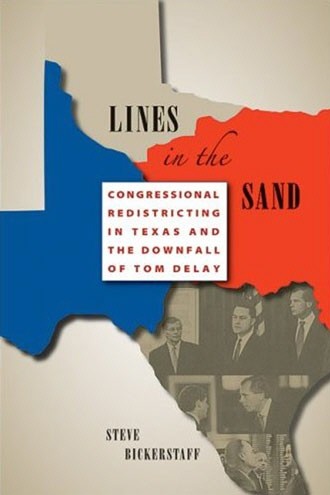|
Lines in the Sand: Congressional Redistricting in Texas and the Downfall of Tom Delay by Steve Bickerstaff 2007, University of Texas Press $34.95, 472 pages Steve Bickerstaff Book Signing Thu April 5, 5pm The Twig Book Shop 5005 Broadway St. 826-6411 |
Throughout most of the 20th century, the Democratic Party maintained control of Texas in part by determining the shapes of districts. By 2003, however, the Republican Party was in control not only of both houses of the Texas legislature but also of every statewide office, and it pulled off what Steve Bickerstaff calls “a masterpiece of partisan engineering.” According to Bickerstaff, an adjunct professor at the University of Texas School of Law who has 30 years of trial experience in election law, “It is the most carefully designed and effectively gerrymandered plan that I have ever seen.”
Article I Section 2 of the Constitution mandates that a census of the population of the United States be taken every 10 years to determine apportionment of the House of Representatives. The 2000 U.S. Census provided the basis for the redistricting that Texas implemented in 2001. Two years later, in a maneuver that amounted to a bloodless coup d’etat, the state reconfigured its 32 congressional districts again, with Republican leadership saying the census figures were outdated; the population of Texas had increased by about 1.3 million. But credit outside pressure and instruction as the real prompt for Texas to redraw its congressional boundaries along lines that spurned the “one person one vote” standard of equal representation.
Moreover, the Voting Rights Act required Texas to submit any change in election procedure for preclearance to ensure that minority rights would not be affected. The career professionals within the Voting Section of the Department of Justice unanimously rejected the redistricting plan, but, in a pattern duplicated by commissars within the EPA, FDA, Forestry Service, and other federal agencies, they were overruled by political appointees within the DOJ. (The partisan interference with government litigation anticipated the Bush administration’s recent sacking of federal prosecutors who had been commended for their job performance.)
The goal of this unprecedented mid-decade redistricting was to purge the state’s congressional delegation of as many Democrats as possible. Ten incumbents were special targets, and their districts were gerrymandered to reduce Democratic constituents or pit one against another; meanwhile, cynical attempts were made to peel Hispanic and African-American legislators away from Democratic allies. This radical scheme was designed to transform the Texas Democratic Party into a permanent minority — a party that represented only minorities and could never again win statewide office. By sending more Republicans to Washington, the plan enlarged the majority for then House Majority Leader, Tom DeLay.
In Lines in the Sand, Bickerstaff, who will sign copies of his book at The Twig on April 5, offers an exhaustive analysis of the machinations that transformed the Texas congressional delegation from 17 Democrats and 15 Republicans to 21 Republicans and 11 Democrats. He explains the intricacies of election laws and legislative procedures, and he provides an hour-by-hour account of the hasty departure by Democratic members of the Texas House to Ardmore, Oklahoma, and the Senate to Albuquerque, New Mexico, in order to deny a quorum and stymie redistricting. However, attempts to block the Republican juggernaut failed, and the bill that Governor Rick Perry signed on October 13, 2003 was, according to Bickerstaff, “a textbook example of how to design districts to maximize the election of candidates from one political group and to minimize the election possibilities for selected candidates from another political group.”
Bickerstaff has written the textbook on that example, and students of political science, law, and history will find much to ponder in the information contained and repeated, at numbing length, within its pages. The volume draws on interviews, transcripts, and personal observations, but it seems to have been composed in self-contained segments, as if the author and his editor were oblivious to blocks of identical prose. In one explanation for the book’s title, we are told that: “The district lines in the redistricting plans were entirely mutable, like lines drawn in the sand.” And only six pages later that: “The lines drawn by the House and Senate were entirely mutable — no more than lines in the sand.”
Lines in the Sand reads as gracefully as a tax statute. Aside from his treatment of the exiles in Ardmore and Albuquerque, Bickerstaff misses his chance at drama, or at least to make compost out of the ordure of Lone Star politics. Perhaps it suffices to quote Perry’s inane statement on signing the redistricting bill: “My taste is sweet in my mouth.”
But DeLay, the unctuous opportunist who went AWOL from Washington to spend days in Austin twisting arms and banging heads, deserves the pen of Dickens. The whole disgraceful mess cries out for Jeremiah, or least Molly Ivins. The punitive plans devised in secret by a tiny cabal were not even welcomed by Texas Republicans. While opposing the loss of rural clout within his own reconfigured district, Bill Ratliff, the Republican acting lieutenant governor, feared for the bipartisan comity that had characterized the Senate he loved. “You get to a point,” said Democratic U.S. Rep. Pete Gallego, responding to DeLay’s contempt for consensus, “when you draw a line in the sand on principle.”
When William Travis drew a line in the Alamo sand, it was a prelude to annihilation. Lines in the Sand went to press before Henry Bonilla, whose 23rd district had been so flagrantly redesigned to protect his incumbency that a federal court intervened, was defeated for re-election by Ciro Rodriguez, a veteran Congressman gerrymandered out of a different district. DeLay, whom Sophocles might have cast as tragic hero (except that he lacked noble qualities even before his fall), awaits trial on felony charges: his formerly safe Republican seat is now occupied by a Democrat, Nick Lampson. Yet most of the gerrymander remains, at least until 2010, when Texas is expected to gain as many as four additional members of Congress. And millions of dollars that might have been spent on education, health care, and environmental protection have been blown away, over mutable lines in the grimy sand.



















